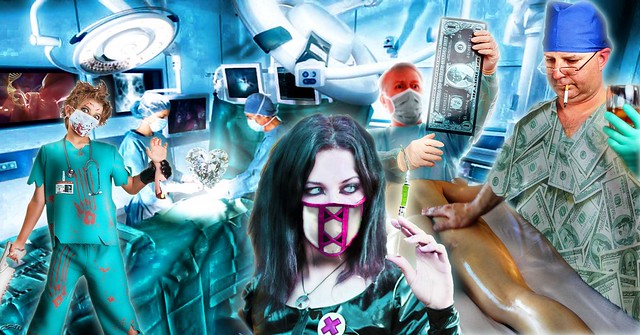Medical Errors Killing Multitudes
Misdiagnosis in America: Shocking
Statistics
by Dr.
Mercola
Most people will suffer from at least one wrong or delayed medical diagnosis during their lifetime, according to the latest data. Americans experience about 12 million diagnostic errors a year, the IOM report revealed.
Conservatively, the report found that 5 percent of US adults who seek outpatient care will experience a diagnostic error. Further, such errors are thought to contribute to 10 percent of patient deaths and 17 percent of adverse events in hospitals.
They’re also the leading type of paid medical malpractice claims and are nearly twice as likely to have resulted in the patient’s death compared to other claims.
Devastating Diagnostic Mistakes Are Claiming Patients’ Lives
“Getting the right diagnosis is a key aspect of health care: It provides an explanation of a patient’s health problem and informs subsequent health care decisions.
For decades, diagnostic errors — inaccurate or delayed diagnoses — have represented a blind spot in the delivery of quality health care. Diagnostic errors persist throughout all settings of care and continue to harm an unacceptable number of patients,” the IOM report stated.
Diagnostic errors are often incredibly harmful to patients as they may lead to delays in treatment, lack of treatment, inappropriate, or unnecessary treatment. This, in turn, can have physical, psychological, and financial consequences.
Causes are varied but include inadequate communication between physicians and patients, a health care system design that does not support the diagnostic process, limited feedback to clinicians about diagnostic performance, and a health care culture that discourages transparency, so diagnostic mistakes are typically not reported (and not learned from).
Dr. Peter Pronovost, director of the Armstrong Institute for Patient Safety and Quality at Johns Hopkins, told CNN:2
“It’s probably one of the, if not the, most under-recognized issues in patient safety… Much of the harm that we once labeled as inevitable we’re now seeing as preventable.”
CNN noted several examples of diagnostic mistakes included in IOM’s report:3
- A 51-year old woman with a family history of heart disease repeatedly asked her doctors’ office to refer her to a cardiologist for a stress test. Three months after her initial request, on the day of her appointment, she died because of significant coronary artery disease.
- A doctor mistook a blood clot in the lungs of a 33-year old woman for an asthma attack, leading to her death.
- An urgent care clinician misread an X-ray and diagnosed a 55-year old man with an upper respiratory infection instead of pneumonia. He died as a result.
- Doctors at a trauma center decided not to perform a CT scan on a 21-year old stabbing victim and missed a knife wound penetrating several inches into his skull and brain.
- A newborn baby suffered preventable brain damage when doctors failed to test for high levels of a chemical in his blood that had turned his skin yellow from head to toe.
‘Urgent Change Is Warranted’
The IOM committee concluded “urgent change is warranted” to protect patients from diagnostic errors, although there’s likely no quick fix available. They recommended a slew of changes, including:
More
training (in medical school and continuing education) in making diagnoses
|
Federal
agencies and employers should encourage the reporting of diagnostic errors to
help others learn how to avoid them
|
Increased
monitoring of how health care facilities are diagnosing patients
|
Encouraging
patients to be involved in their care and share concerns about diagnostic
errors
|
Ensuring
patients have access to electronic health records, diagnostic testing
results, etc. so they can review for accuracy
|
Increased
collaboration among pathologists, radiologists, other diagnosticians, and
health care professions to improve the diagnostic process
|
At the heart of the recommendations is one that virtually everyone reading this should take to heart: a call for patients to become advocates for their own care and voice any concerns or questions. Dr. Pronovost added: “We need to encourage patients to speak up and ensure that when they do speak up, it’s well received.”4
The National Patient Safety Foundation and the Society to Improve Diagnosis in Medicine have a checklist you can use to help ensure you get the correct diagnosis. It includes recommendations such as the following:
Tell
your story well (when symptoms started, what makes symptoms better or worse,
etc.)
|
Remember
what treatments you’ve tried in the past and how the illness has progressed
over time
|
Keep
records of test results, medications, and hospital admissions
|
Learn
about your illness, tests or procedures you’re having done, and/or
medications you’re taking
|
Take
charge of managing your health, and be sure each doctor you’re seeing is
aware of other doctors’ visits, medications you’re taking, test results,
treatments, etc.
|
Be
actively involved in your health care decisions
|
Know
your tests results, including what the results mean
|
Ask
questions, including whether there could be other reasons or causes for your
illness
|
Medical Errors May Cause Nearly Half a Million Deaths Annually
Diagnostic errors are just one type of error that occurs in the medical field, and you might be surprised at just how common errors occur. While the 1999 IOM report blamed 98,000 deaths a year on hospital errors, a 2013 study in the Journal of Patient Safety projected that medical errors now account for 210,000 to 440,000 US deaths annually.5
Even at 210,000, this makes medical errors the third-leading cause of death in the US, right after heart disease and cancer. And when you consider instances where medical errors cause some form of harm but not necessarily death, the incidence rate may be as high as 40,000 per day!6 These are frightening numbers that deserve immediate attention, as the researchers noted:
“In a sense, it does not matter whether the deaths of 100,000, 200,000, or 400,000 Americans each year are associated with PAEs [preventable adverse events] in hospitals. Any of the estimates demands assertive action on the part of providers, legislators, and people who will one day become patients.
Yet, the action and progress on patient safety is frustratingly slow; however, one must hope that the present, evidence-based estimate of 400,000+ deaths per year will foster an outcry for overdue changes and increased vigilance in medical care to address the problem of harm to patients who come to a hospital seeking only to be healed.”
Seniors May Be Particularly at Risk
Yet another study of more than 12,500 Medicare patients (with an average age of 76) found that nearly one in five suffer from medical injuries when receiving care.7 Injuries included:
- Being given the wrong medicationd
- Having an allergic reaction to a medication
- Receiving treatment that led to more complications of an existing medical problem
Previous studies have found about 13.5 percent of hospitalized patients suffer from adverse medical events, but the featured study found about 19 percent of seniors are harmed by medical care. Older people, men, those with lower incomes, and people with disabilities were at an even greater risk. Further, the risk of an adverse medical event rose 27 percent for each chronic medical condition a person had.8 The study’s lead researcher noted:
“These injuries are caused by the medical care or management rather than any underlying disease… The rate of these injuries is probably higher than has been estimated.”
What Medical Errors Should You Watch Out For?
Hospitals often make such egregious errors as treating the wrong patient, leaving behind surgical tools in a person after surgery, losing patients, or operating on the wrong body part. Air bubbles in your blood after a chest tube is removed, mix-ups involving medical tubing, and hospital-acquired infections are other examples of sometimes fatal medical errors that are all too common – and preventable.
Any time you’re in a health care setting, be sure to ask questions – double check the treatments you’re receiving, the dosages of medications, and the diagnosis you’re given – and if possible bring a family member or friend with you for an extra set of eyes and ears.
Further, be aware that more than 2 million people are affected by hospital-acquired infections each year, and a whopping 100,000 people die as a result. According to the 2011 Health Grades Hospital Quality in America report, analysis of approximately 40 million Medicare patients’ records from 2007 through 2009 showed that 1 in 9 patients developed such hospital-acquired infections!9 The saddest part is, most of these cases could likely have been easily prevented with better infection control in hospitals — simple routines such as doctors and nurses washing their hands between each patient, for example.
So make sure doctors, nurses, and other health care providers wash their hands before touching you; if you feel uncomfortable speaking up… realize that doing so could literally save your life.
One of the reasons I am so passionate about sharing the information on this site about healthy eating, exercise, and stress management is because it can help keep you OUT of the hospital and other health-care danger zones. You can use this site to find well-proven strategies that will address most chronic health problems.
Please remember you can always use the search engine at the top of every page on the site to review previous articles we have written. If you have an acute injury or life-threatening medical situation, of course you need to seek immediate competent care.
How to Stay Safe If You’re Hospitalized
Dr. Martin Makary is the author of The New York Times bestselling book Unaccountable: What Hospitals Won’t Tell You and How Transparency Can Revolutionize Healthcare, which is a story about the dangerous practices and mistakes of modern medicine. In the interview above, you can learn some important tips to stay safe if you find yourself in a hospital. Once you’re hospitalized, you’re immediately at risk for medical errors, so one of the best safeguards is to have someone there with you. Dr. Andrew Saul has also written an entire book on the issue of safeguarding your health while hospitalized.
One of the best suggestions is simply to have someone there to act as your personal advocate, or to take the time to stay with your loved one who is hospitalized. This is particularly important for pediatric patients and the elderly.
“Sometimes, we rely on a competent talking patient to help verify what we’re doing before we go in the operating room. But if we got somebody who’s not mentally coherent because they’re elderly or a kid and there’s no family member around, these are danger zones. These are high-risk areas for medical mistakes,”
Dr. Makary warns,“It’s important to ask what procedure’s being done or why is the procedure being done. ‘Can I talk to the doctor?’ You have a right to know about what’s being done to you or your loved one in the hospital. When you’ve got a kid in the hospital, I think it’s particularly important to ask the questions.”
For every medication given in the hospital, ask, “What is this medication? What is it for? What’s the dose?” Take notes. Ask questions. Building a relationship with the nurses can go a long way. Also, when they realize they’re going to be questioned, they’re more likely to go through that extra step of due diligence to make sure they’re getting it right — that’s human nature. Dr. Makary also co-developed a checklist for surgeons to use before surgery or any other hospital procedure.
Dr. Pronovost, who is Dr. Makary’s research partner, created a checklist in the ICU for patients who are in the intensive care unit. The World Health Organization (WHO) ended up taking an interest in their checklists and used some of their principles to develop the official World Health Organization checklist.
The WHO surgical safety checklist and implementation manual,10 which is part of the campaign “Safe Surgery Saves Lives” that Drs. Makary and Pronovost were a part of, can be downloaded here. If a loved one is in the hospital, print it out and bring it with you, as this can help you protect your family member or friend from preventable errors in care.
From Dr Mercola
@ http://articles.mercola.com/sites/articles/archive/2015/09/30/diagnostic-errors.aspx
via http://www.wakingtimes.com/2016/09/04/misdiagnosis-america-shocking-statistics/
For more information about medical malpractice see http://nexusilluminati.blogspot.com/search/label/medical%20malpractice
- Scroll down
through ‘Older Posts’ at the end of each section
Do you LIKE this uniquely informative site?
Hours of effort by a genuinely incapacitated invalid are
required every day to maintain, write, edit, research, illustrate, moderate and
publish this website from a tiny cabin in a remote forest.
Now that most people use ad blockers and view these posts
on phones and other mobile devices, sites like this earn an ever shrinking
pittance from advertising sponsorship. This site needs your help.
Like what you see? Please give anything you can -
Contribute any amount and receive at least one
New Illuminati eBook!
(You can use a card securely if you don’t use Paypal)
Please click below -
And it costs nothing
to share this post on Social Media!
Dare to care and
share - YOU are our only advertisement!
Xtra Images by R. Ayana – https://c2.staticflickr.com/8/7569/15956460735_a884b6c138_h.jpg
Videos - https://youtu.be/KxUfPBhipLA
For further enlightening
information enter a word or phrase into the random synchronistic search box @
the top left of http://nexusilluminati.blogspot.com
And see
New Illuminati – http://nexusilluminati.blogspot.com
New Illuminati on Facebook - https://www.facebook.com/the.new.illuminati
New Illuminati Youtube Channel - https://www.youtube.com/user/newilluminati/playlists
New Illuminati’s OWN Youtube Videos
-
New Illuminati on Google+ @ For
New Illuminati posts - https://plus.google.com/u/0/+RamAyana0/posts
New Illuminati on Twitter @ www.twitter.com/new_illuminati
New Illuminations –Art(icles) by
R. Ayana @ http://newilluminations.blogspot.com
The Her(m)etic Hermit - http://hermetic.blog.com
DISGRUNTLED SITE ADMINS PLEASE NOTE –
We provide
a live link to your original material on your site (and links via social
networking services) - which raises your ranking on search engines and helps
spread your info further!
This site
is published under Creative Commons (Attribution) CopyRIGHT (unless an individual
article or other item is declared otherwise by the copyright holder). Reproduction
for non-profit use is permitted & encouraged - if you give attribution to the
work & author and include all links in the original (along with this or a
similar notice).
Feel free
to make non-commercial hard (printed) or software copies or mirror sites - you
never know how long something will stay glued to the web – but remember
attribution!
If you
like what you see, please send a donation (no amount is too small or too large)
or leave a comment – and thanks for reading this far…
Live long
and prosper! Together we can create the best of all possible worlds…
From the New Illuminati – http://nexusilluminati.blogspot.com



No comments:
Post a Comment
Add your perspective to the conscious collective